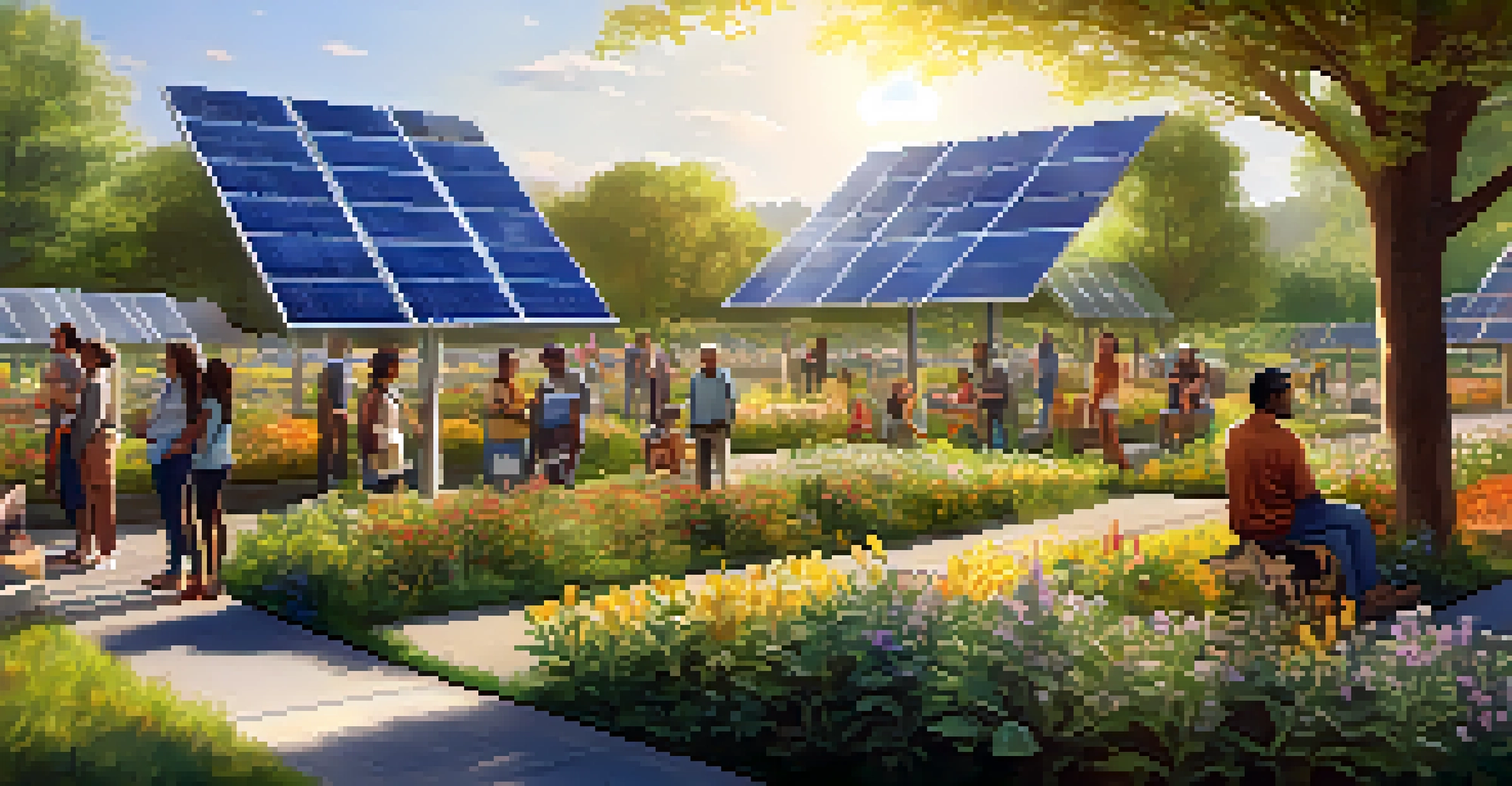Renewable Energy Projects in Sacramento: Current Landscape

Overview of Renewable Energy in Sacramento
Sacramento has positioned itself as a leader in renewable energy within California. With its abundant sunshine and commitment to sustainability, the city has embraced various renewable sources, particularly solar and wind power. This shift not only helps combat climate change but also fosters economic growth through job creation in the green sector.
The future will be green, or not at all.
The local government has implemented policies to encourage investment in renewable projects, which has led to a surge in both public and private initiatives. As a result, Sacramento is on track to meet its ambitious climate goals, aiming for 100% renewable energy by 2030. This transformation is not just about technology; it's about creating a greener future for the community.
The city's commitment to renewable energy is evident in its numerous projects and partnerships aimed at enhancing energy efficiency. From solar installations on public buildings to community solar gardens, Sacramento is setting a precedent for other cities to follow. The growth of this sector is reshaping the local economy and inspiring residents to engage in sustainable practices.
Key Renewable Energy Projects in the Region
Several significant renewable energy projects are currently underway in Sacramento. The Sacramento Municipal Utility District (SMUD) has been a pioneer in integrating large-scale solar farms into the grid, making clean energy accessible to thousands of residents. One notable project is the 250-megawatt solar facility, which significantly boosts the city's renewable energy capacity.

Another impressive initiative is the Folsom South Canal Solar Farm, which combines solar energy production with water conservation. This innovative project not only generates clean electricity but also reduces evaporation in the canal, showcasing the potential of dual-purpose land use. Such projects reflect Sacramento's commitment to maximizing its natural resources while minimizing environmental impact.
Sacramento's Renewable Energy Leadership
Sacramento is leading California's renewable energy efforts, aiming for 100% renewable energy by 2030 through solar and wind initiatives.
In addition to solar, wind energy is gaining traction in the Sacramento area. The installation of small wind turbines in rural communities provides an additional renewable source of energy. These projects highlight the diverse approaches Sacramento is taking to diversify its energy portfolio and ensure a resilient energy future.
Community Involvement in Renewable Energy
Community engagement plays a vital role in the success of renewable energy projects in Sacramento. Residents are encouraged to participate in programs like community solar, where they can invest in shared solar energy systems. This initiative allows those who may not have suitable rooftops for solar panels to still benefit from clean energy.
We do not inherit the earth from our ancestors; we borrow it from our children.
Local organizations and advocacy groups are actively promoting awareness and providing resources for sustainable living. By hosting workshops and informational sessions, they empower residents to make informed decisions about energy use and conservation. This grassroots approach fosters a sense of ownership and responsibility toward the environment.
Moreover, schools in Sacramento are integrating renewable energy education into their curriculums. This not only prepares the next generation to tackle environmental challenges but also instills values of sustainability and conservation from a young age. The community's active participation is crucial in creating a culture of sustainability that extends beyond individual projects.
Challenges Facing Renewable Energy Development
While Sacramento is making strides in renewable energy, challenges remain. One significant hurdle is the initial cost of renewable energy technologies, which can be a barrier for some residents and businesses. Although prices have been declining, upfront investments may still deter participation.
Additionally, regulatory hurdles can slow down project implementation. Navigating permits and compliance with various environmental regulations often requires significant time and resources. These challenges highlight the need for streamlined processes that can facilitate quicker adoption of renewable energy solutions.
Community Engagement Drives Initiatives
Active community involvement in programs like community solar is essential for promoting sustainable practices and enhancing awareness of renewable energy.
Finally, public perception and awareness can impact the growth of renewable energy projects. Some residents may be skeptical about the reliability or efficiency of renewable sources. Addressing these concerns through education and transparent communication is essential for building trust and encouraging broader participation in Sacramento's renewable energy initiatives.
The Role of Government Policies in Energy Transition
Government policies play a crucial role in shaping the renewable energy landscape in Sacramento. Incentives such as tax credits, rebates, and grants encourage both individuals and businesses to invest in solar and other renewable technologies. These financial incentives make transitioning to renewable energy more accessible and appealing.
Furthermore, state-level mandates, such as California's Renewable Portfolio Standard, require utilities to source a significant portion of their energy from renewable sources. These regulations push local governments and companies to innovate and invest in clean energy projects. Sacramento's alignment with these policies demonstrates its commitment to leading by example.
Local initiatives, such as the Sacramento Climate Action Plan, outline specific targets and strategies for reducing greenhouse gas emissions. By setting clear goals and providing a roadmap for achieving them, these policies help coordinate efforts across various sectors and stakeholders. This collaborative approach is vital for successfully transitioning to a cleaner energy future.
Impact of Renewable Energy on Local Economy
The growth of renewable energy projects in Sacramento is having a positive impact on the local economy. Job creation in the green sector is on the rise, with positions ranging from solar panel installation to energy efficiency consulting. This influx of employment opportunities not only supports families but also strengthens the community as a whole.
Additionally, the renewable energy sector has attracted investments from both public and private entities. These investments stimulate economic development and foster innovation, paving the way for new technologies and business models. This trend is particularly beneficial for local startups focused on sustainability.
Economic Benefits of Green Projects
The growth of renewable energy projects is boosting job creation and attracting investments, positively impacting Sacramento's local economy.
Moreover, as more residents adopt renewable energy solutions, there is potential for decreasing utility costs over time. By reducing reliance on fossil fuels, Sacramento can enhance energy independence and stability. This economic shift not only benefits individual households but also contributes to the overall resilience of the local economy.
Future Trends in Sacramento's Renewable Energy Sector
Looking ahead, Sacramento's renewable energy landscape is poised for exciting developments. Advances in technology, such as energy storage systems, are expected to enhance the reliability and efficiency of renewable energy sources. These innovations will allow for better integration of renewables into the grid, ensuring a consistent energy supply even during peak demand.
Furthermore, the city is exploring opportunities in emerging technologies, such as hydrogen fuel and electric vehicle charging infrastructure. These trends reflect a broader commitment to sustainability and a holistic approach to energy consumption. As Sacramento continues to innovate, it may become a model for other cities striving for a green future.

Lastly, community-driven initiatives will likely play an increasingly vital role. As awareness of climate issues grows, residents are becoming more proactive in advocating for sustainable practices. This grassroots momentum can help shape policies and projects that align with the community's vision for a cleaner, greener Sacramento.